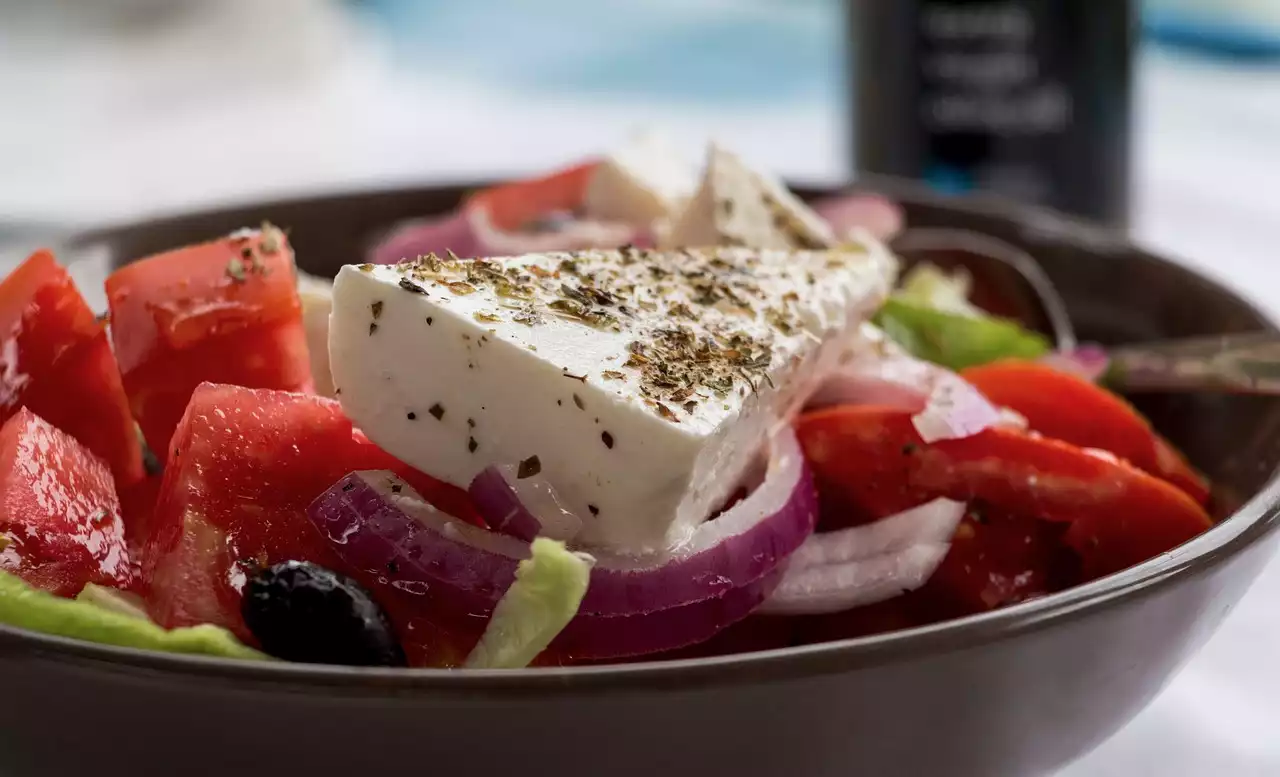The Key Ingredients of a Typical Greek Meal
Greek cuisine is a harmonious blend of fresh ingredients, aromatic herbs, and wholesome flavors. The key ingredients that form the foundation of a typical Greek meal include olive oil, fresh vegetables, seafood, cheese, and yogurt. These ingredients are combined in various ways to create a diverse range of dishes that showcase the best of Greek culinary traditions.
Olive oil, often referred to as "liquid gold," is the cornerstone of Greek cooking. It is used liberally in almost every dish, adding a rich, fruity flavor and a silky texture. The Greeks take great pride in their olive oil production, with each region producing oil that is unique in flavor and character. Whether drizzled over a Greek salad or used to sauté vegetables, olive oil is the golden thread that weaves Greek cuisine together.
Fresh vegetables play a prominent role in Greek cooking, with tomatoes, cucumbers, bell peppers, eggplants, and zucchini being staples in many dishes. These vegetables are often used raw in salads or roasted and stewed to create hearty vegetarian dishes. The abundance of sunshine in Greece gives the vegetables a vibrant color and intense flavor, making them the perfect canvas for showcasing the simplicity and freshness of Greek cuisine.
Seafood is another star ingredient in Greek cooking, thanks to Greece's extensive coastline. From grilled octopus to fried calamari and baked fish, seafood dishes are a testament to the Greek love for the sea. The Mediterranean waters surrounding Greece are teeming with a variety of fish and shellfish, providing an endless array of options for seafood lovers. Whether you're enjoying a seafood mezze platter or a traditional fisherman's stew, the flavors of the sea are always present in Greek cuisine.
Cheese holds a special place in Greek culinary traditions, with feta being the most famous variety. Made from sheep's milk, feta cheese is crumbly, tangy, and salty, adding a burst of flavor to salads, pies, and pastries. Other popular Greek cheeses include halloumi, kefalotyri, and graviera, each with its own unique taste and texture. Greek cheeses are not only enjoyed on their own but also used as a versatile ingredient in many savory dishes.
Yogurt is another staple in Greek cuisine and is often enjoyed as a standalone snack or used as a base for sauces and dips. Greek yogurt is thick, creamy, and tangy, making it the perfect accompaniment to grilled meats, roasted vegetables, and even desserts. Its versatility and health benefits have made it a favorite among health-conscious food enthusiasts worldwide.
Traditional Greek Dishes and Their Origins
Greek cuisine is a tapestry of traditional dishes that have been passed down through generations. Each dish carries with it a rich history and a story of its origins, reflecting the diverse influences that have shaped Greek culinary traditions. Let's explore some of the most iconic Greek dishes and the regions they originate from.
1.
Moussaka (Northern Greece): Originating from the northern regions of Greece, moussaka is a hearty casserole made with layers of eggplant, ground meat (typically lamb or beef), and béchamel sauce. It is baked until golden and served warm, with each forkful offering a combination of creamy béchamel, tender eggplant, and flavorful meat.
2.
Souvlaki (Athens): Souvlaki is a quintessential Greek street food that originated in Athens. It consists of skewered and grilled pieces of marinated meat, usually pork or chicken, served in a warm pita bread with tzatziki sauce, tomatoes, onions, and sometimes fries. Souvlaki is a portable and delicious meal that can be enjoyed on the go or as part of a leisurely lunch.
3.
Dolmades (Crete): Dolmades are stuffed grape leaves that are popular in Greek cuisine. The filling typically consists of rice, herbs, and sometimes ground meat, rolled tightly in grape leaves and then cooked until tender. Dolmades are often served as an appetizer or side dish, and their tangy flavor and delicate texture make them a favorite among both locals and visitors.
4.
Spanakopita (Peloponnese): Spanakopita is a savory pastry filled with spinach, feta cheese, herbs, and sometimes onions or leeks. The filling is encased in layers of crispy phyllo pastry and baked until golden. This dish hails from the Peloponnese region of Greece and is a popular option for breakfast, lunch, or a light dinner.
5.
Gemista (Islands): Gemista, also known as stuffed vegetables, is a beloved dish found throughout the Greek islands. It typically consists of tomatoes, peppers, zucchini, or eggplants that are hollowed out and filled with a mixture of rice, herbs, and sometimes ground meat. The stuffed vegetables are then baked until tender, resulting in a comforting and flavorful dish.
Regional Variations in Greek Cuisine
Greece's diverse geography and rich cultural heritage have given rise to a variety of regional variations in Greek cuisine. Each region has its own unique ingredients, cooking techniques, and traditional dishes that showcase the local flavors and culinary traditions. Let's take a culinary tour of some of Greece's most famous regions and discover their distinct culinary identities.
1.
Crete: Known for its healthy and flavorful cuisine, Crete is famous for its use of fresh herbs, extra virgin olive oil, and locally sourced ingredients. Cretan cuisine is characterized by dishes such as dakos (a salad made with barley rusks, tomatoes, and feta cheese), kalitsounia (small cheese or herb pies), and staka (a rich, creamy butter made from sheep's milk). The island's abundance of wild greens, aromatic herbs, and unique cheeses make it a paradise for food lovers.
2.
Santorini: Located in the Cyclades islands, Santorini is renowned for its sun-soaked vineyards, volcanic soil, and breathtaking views. The island's cuisine is influenced by its volcanic landscape, with ingredients like cherry tomatoes, white eggplants, capers, and fava beans taking center stage. Signature dishes from Santorini include tomatokeftedes (tomato fritters), fava (a creamy yellow split pea dip), and grilled sea bass.
3.
Thessaloniki: As Greece's second-largest city, Thessaloniki is a melting pot of cultures and flavors. The city's cuisine reflects its multicultural history, with influences from the Ottoman Empire, the Balkans, and the Middle East. Thessaloniki is known for its vibrant street food scene, where you can indulge in treats like bougatsa (a sweet or savory pastry filled with cheese or custard), souvlaki, and the famous Thessaloniki-style gyros.
4.
Peloponnese: The Peloponnese peninsula is a treasure trove of culinary delights, with its fertile lands and diverse landscape. The region is known for its olive oil production, honey, citrus fruits, and fresh seafood. Traditional dishes from the Peloponnese include spetsofai (a spicy sausage and bell pepper stew), rooster in red wine sauce, and pasteli (a sesame seed and honey bar).
The Role of Olive Oil in Greek Cooking
When it comes to Greek cuisine, olive oil is more than just an ingredient; it's a way of life. Greek olive oil is renowned for its exceptional quality and distinct flavor profile, making it a prized ingredient in kitchens around the world. Let's explore the role of olive oil in Greek cooking and the reasons behind its prominence.
Olive oil has been an integral part of Greek culture for thousands of years, with olive trees deeply intertwined with the country's history and mythology. The Greeks consider the olive tree a sacred symbol of peace, wisdom, and prosperity. The olive tree's longevity and resilience are reflected in the high-quality olive oil it produces.
In Greek cooking, olive oil is used in almost every aspect of meal preparation. It is drizzled over salads, used to sauté vegetables, dress roasted meats, and even added to desserts for a touch of richness. The distinct flavor of Greek olive oil varies depending on the region and the type of olives used, ranging from fruity and grassy to peppery and robust.
Apart from its flavor, olive oil is also highly valued for its health benefits. Greek olive oil is rich in monounsaturated fats, which are known to promote heart health and reduce the risk of chronic diseases. It is also packed with antioxidants and anti-inflammatory compounds that contribute to overall well-being.
The process of producing Greek olive oil is steeped in tradition and meticulous care. Olives are harvested by hand to ensure the highest quality, then pressed within hours to preserve their freshness and flavor. The resulting olive oil is often unfiltered, allowing it to retain its natural aromas and flavors.
Greek olive oil is not just a cooking ingredient; it is a cultural symbol that represents the essence of Greek cuisine. Its presence in every Greek meal is a testament to the country's rich culinary heritage and the deep connection between food, tradition, and the land.
Popular Greek Desserts and Pastries
Greek cuisine is not just about savory dishes; it also boasts a wide array of delectable desserts and pastries that are loved by locals and visitors alike. From delicate pastries soaked in syrup to rich custards and nut-filled delights, Greek desserts are a sweet ending to any meal. Let's explore some of the most popular Greek desserts and pastries that will satisfy your sweet tooth.
1.
Baklava: Baklava is perhaps the most famous Greek dessert, with its layers of buttery phyllo pastry filled with a mixture of ground nuts (such as walnuts or pistachios) and sweetened with a fragrant syrup made of honey, sugar, and lemon juice. The result is a crunchy, sticky, and irresistibly sweet treat that is often enjoyed with a cup of Greek coffee.
2.
Loukoumades: Loukoumades are bite-sized, deep-fried dough balls that are crispy on the outside and fluffy on the inside. They are traditionally drizzled with honey, sprinkled with cinnamon, and sometimes topped with chopped walnuts or sesame seeds. Loukoumades are a popular street food in Greece and are often enjoyed during festivals and special occasions.
3.
Galaktoboureko: Galaktoboureko is a classic Greek dessert made with layers of crispy phyllo pastry filled with a creamy semolina custard and soaked in a sweet syrup. The custard is flavored with vanilla and lemon zest, giving the dessert a refreshing and aromatic twist. Galaktoboureko is often served in square or rectangular pieces and is best enjoyed chilled.
4.
Revani: Revani is a moist semolina cake soaked in a fragrant syrup made with sugar, water, and lemon juice or rosewater. The cake is often flavored with orange zest or vanilla and can be topped with almonds or pistachios for added crunch. Revani is a popular dessert in Greece, especially during festive occasions and family gatherings.
5.
Koulourakia: Koulourakia are buttery, twisted cookies that are often enjoyed with a cup of Greek coffee or tea. They are typically flavored with vanilla, orange zest, or a combination of spices like cinnamon and nutmeg. Koulourakia come in various shapes and sizes, with each family having their own unique recipe and twist.
Greek desserts and pastries are a testament to the country's love for sweet indulgence and the art of pastry-making. Whether you're enjoying a traditional baklava or savoring a delicate slice of galaktoboureko, Greek desserts are a treat for the senses and a celebration of the country's rich culinary heritage.
Greek Dining Customs and Traditions
In Greece, dining is not just about nourishment; it is a social ritual that brings people together and strengthens bonds. Greek dining customs and traditions are deeply rooted in the country's history and culture, reflecting the values of hospitality, togetherness, and the joy of sharing food. Let's explore some of the unique customs and traditions that make dining in Greece a memorable experience.
1.
Meze Culture: Meze is a beloved Greek tradition that involves sharing a variety of small dishes, similar to Spanish tapas or Middle Eastern mezze. Meze is often enjoyed with drinks, such as ouzo or tsipouro, and includes a selection of appetizers like tzatziki, feta cheese, olives, dolmades, grilled octopus, and spanakopita. Meze is all about savoring bite-sized portions of different flavors, encouraging conversation and a leisurely dining experience.
2.
Breaking Bread: Bread holds a special place in Greek dining customs, symbolizing hospitality and the act of breaking bread together. It is customary to offer a piece of bread to guests as a gesture of welcome and friendship. Bread is often served with olive oil and olives or used to mop up delicious sauces and juices from main dishes.
3.
Family-Style Dining: Greek











